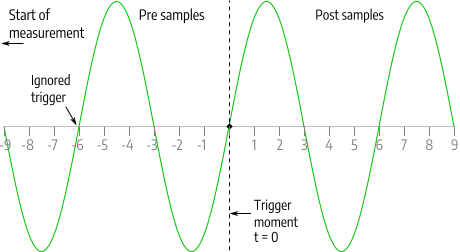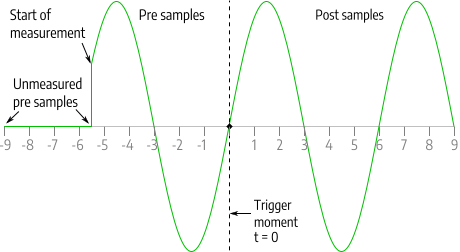When measuring pre samples, there are two possible moments to enable the trigger system:
- Pre samples valid enabled: when number of pre samples are measured after starting the measurement.
- Pre samples valid disabled: immediately when starting the measurement
Pre samples valid enabled
When the trigger system is enabled after measuring number of pre samples after starting the measurement, and a trigger occurs, all pre samples will be measured and will show the actual signal.

The advantage of enabling the trigger system after number of pre samples is that all pre samples are valid and no confusion may rise. A disadvantage of enabling the trigger system number of pre samples is that during measuring the pre samples, the trigger system is not active yet. If a trigger occurs while still measuring the pre samples, this trigger is ignored and the measurement not captured. When measuring a periodical signal this may not be a problem, but when trying to capture an intermittent phenomenon this may be a big problem.
Pre samples valid disabled
When the trigger system is enabled immediately after starting the measurement, and the first trigger occurs before number of pre samples are measured, a part of the pre samples remains unmeasured. These samples are drawn in the graph as 0 V, at the left hand side of the graph. At the moment the measurement was started, the signal "jumps" to the actual signal value.

The advantage of enabling the trigger system immediately after starting the measurement is that a trigger is never missed. A disadvantage of enabling the trigger system immediately after starting the measurement is that a part of the signal is drawn at 0 V, which may be confusing.
Not all TiePie engineering instruments support the setting Pre samples valid. When it is not supported, the trigger system is enabled immediately after starting the measurement.
